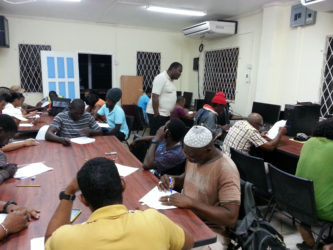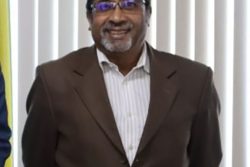With state policy placing increasing emphasis on mining site safety and an environmentally responsible regime of mining practices in the country’s gold mining sector the work of the Guyana Geology and Mines Commission’s (GGMC) Mining School is assuming an increasingly central position in ensuring the integrity of the sector, its Administrator John Applewhite-Hercules has told the Stabroek Business.
During an extended interview,

Applewhite-Hercules said he believed that despite the capacity limitations of the institution, it had enhanced the awareness of both miners and GGMC officials who had experienced the services that it had to offer of the importance of training in key areas of the gold mining sector.
Figures seen by this newspaper indicate that during last year, 492 miners and staff of the GGMC were trained by the Mining School in various courses that included an Introductory, Intermediate and Advanced Level Training Courses for Prospectors, Health and Safety Codes of Practice, First Aid Courses and Accident/Incident Investigation. This compares with 300 persons trained by the Mining School in several of the same disciplines during the previous year. “Now that the mining sector is fully aware of the government’s focus on aggressively embracing the ‘greening’ of the economy and the society the Mining School can hardly pursue a training curriculum the fails to pay attention to that reality,” Applewhite-Hercules said.
Training statistics also indicate that during last year the focus of the Mining School’s training efforts targeted mining communities at Mahdia and Konwaruk as well as initiatives targeting GGMC officials in Georgetown.
Applewhite-Hercules said that while he was satisfied with the impact which the Mining School had at locations where it had effected training he was concerned that the needs of the sector considerably outstripped the reach and capacity of the school. He said that while the school had done intensive work in mining communities like Mahdia and Tiger Creek and was beginning to make a greater impact in areas like Konwaruk and Micobie, he was concerned that some of the heavily populated areas in the Middle Mazaruni, Cuyuni and the North West District where gold production was high, the impact of the school was below what might have been expected. He said that “a lack of resources, staff and logistics” continued to be the primary reasons for the continued limitations of the Mining School. While the school had already created and equipped centres at Mahdia, Bartica and Linden, staff limitations continued to challenge the operationalizing of those centres.
Meanwhile, Applewhite-Hercules said that much of the school’s focus this year will be on work aimed at enhancing environmental practices in the sector. Towards this end he disclosed that a collaborative initiative with Conservation International was being sought with a view to further exploring the possibility of mercury-free alternatives for the sector. Work is also expected to be done this year on the use of flocculants to reduce the turbidity of the discharge from mining pits.
Applewhite-Hercules also said that this year the school will be seeking to engage the Environmental Protection Agency to pursue discourses aimed at harmonizing training to ensure that it remains relevant to their requirements.
Applewhite-Hercules, meanwhile, singled out the increased capacity to employ technology in various facets of mining and mining oversight as one of the key accomplishments of the Mining School. He said that 25 GGMC officials had already been trained in the use of QGIS software – a geographic information systems tool that provides capabilities to help visualize, manage, edit, analyze data and compose printable maps and as a consequence now possess the capacity to undertake the kind of monitoring that would enable them to determine the extent of the vulnerability of mining pits to collapse.








